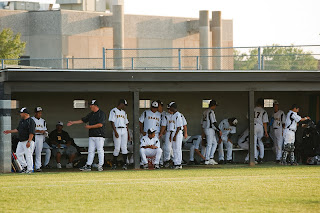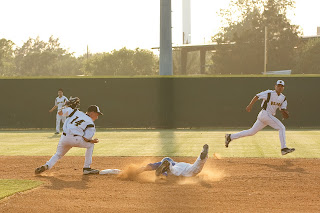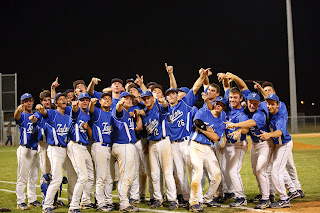Two months ago, I was asked to photograph baseball and softball play-offs for
The Grind, an online publication that highlights the athletic achievements of students on the west side of Houston in general and
Katy ISD sports in particular. Katy is known for consistently helping students achieve success in sports with many of them getting full ride scholarships to universities and some even entering the pro leagues. The focus of The Grind is not to concentrate on the negative, i.e. how a particular student's scoring average is less consistent or less reliable than what it used to be, but it tries to focus on highlighting the successes of the team as a whole.
As some of my readers will know, I know very little about baseball or softball for that matter. I can tell you about soccer (having coached it) as well as the intricacies of rugby and cricket, both of which I played as a schoolboy while attending
Selborne College in East London and
Jeppe High School for Boys in Johannesburg, South Africa. I am somewhat better versed in American football, because my sons played it while in middle school and the moment I figured out how the game was played, I became the parent that would call the referee out on bad calls, and yes, there were some.
Back to the present. It's a strange feeling to walk up to a baseball game, camera with long lens slung over your shoulder and to know virtually nothing about the game. It would be akin to someone not knowing a thing about "Lost" holding a conversation about the actors, plot etc over drinks!

I entered the bullpen, mingled with the players, introduced myself to the coaches who, for the most part, are really decent down-to-earth people. Oh, the
prima donnas (Italian for First Ladies) who hold themselves to be above everyone else exist, but not in Katy. I could name names and schools, but that won't help the kids and I refuse to behave in a manner similar to them.

It's a late sun-soaked Texas afternoon, the air sticky with humidity. The bullpen is filled with screaming girls or grunting guys whooping and high-fiving each other and I start shooting at a low ISO, around 200, speed up high to try to capture the ball in mid-flight as the pitcher hurls it towards the batter (is that even a word?) who in turn tries to slug it out of the field. Aperture is about f/5.6 so that I can capture the pitcher or batsman in action. I get lucky, get a few decants shots. Wait, you say. What lens are you using?
Canon 70-200 f/2.8 L II, oh and I'm hand-holding it. As the sun goes down and the ballpark lights come on, I have to increase my ISO first up to 800 until at last I am at 1600.

More than that and digital noise will become more and more evident in the prints. The problem is that stadium lights just are NOT bright enough, so as it gets darker and darker I have to open the aperture more and more going down to f/2.8. The sky becomes darker, but the digital camera captures the most incredible hues of blue: indigo, blue-black, blue-purple. This has to be my favourite time of day. This is dusk, the magical hour. The game however doesn't stop. Batsmen sprint to 1st base, steal and slide in to second base, make a mad dash for 3rd and head for home plate when they are caught out. As the quality of light continues to diminish rapidly, I am forced to slow down the shutter speed. There is no chance that I can capture the ball in mid-air any longer. It becomes a stripe, a white smudge with a slight arc curving in towards the batsman or ending up in the catcher's gloved hands.
The pace and energy of the game doesn't generally slacken. Occasionally, one team gives up the fight and decide to just play ball. The adrenaline levels fall and weariness sets in. My shoulders, arms and back ache and my eyes struggle to focus. I cannot flag, because there is another game I must shoot before the night is over.

Finally, the end comes. Sometimes it's a close call, merely one run apart. Other times it's a whitewash, the losing team getting one run and the winning team scoring 13! The players line up to greet each other following the game, each hammering the side of their opponents' closed-fist as they walk past each other. I capture some final shots of key players and the coach and then head to the next game.
Some will say, hang on. That 70-200mm lens is great, but shooting sports with it? It's like trying to cut a steak using a spoon! You're right. It is not the best lens to use for the job I'm doing. I could use a 1.4x converter and get a little more distance out of it, but I will also lose a stop of light. Another option is that I could buy a bigger lens, something like the
Canon Telephoto EF 300mm f/2.8 L IS USM, but that costs around $4500. I tried the new
Sigma 50-500mm DG OS HSM APO but the aperture is only f/4.5-6.3. No optimal at all and I got absolutely NO benefit using it in low light. that "mutha" is HEAVY! I was unable to hold it in my hands without shaking like a leaf in the wind. I used a monopod to provide some measure of stability, but the lens just isn't fast enough for night-time sports. Their is simply no way that I can capture a batsman sliding into base at f/6.3 at 1/30 second even if I am panning. The Sigma 50-500mm would be great if you were shooting your dog or kids or birds or wildlife during the day, but as soon as nightfall approaches, don't even think about it.
Now that we are into bi-district playoffs, and heading into games that determine the State Champions, I may have to just suck it up and rent a longer, faster lens from my friend Roger Cicala at
LensRentals.com, but they are expensive all the same.
In case you're wondering if I've learned anything about baseball, Doug Johnson, the editor of
The Grind, sat me down over a beer and gave me a few pointers. None of his advice helps me understand the Astros. They still suck! Thank goodness for Katy sports!










